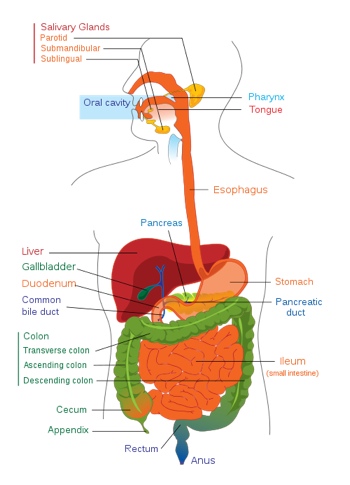
The Gastrointestinal System
last authored:
last reviewed:
Introduction
The gastrointestinal system is a collection of very different organs, all working towards digestion, absorption, and metabolism of food and water.

The mouth begins digestion, while the esophagus transports food to the stomach, where mechanical digestion occurs.
The small intestine is responsible for the bulk of digestion and absorption. The large intestine (colon, bowel) removes water and nutrients prior to defecation.
The pancreas secretes hormones into the small intestine to assist in digestion and also into the blood to regulate blood glucose levels.
The liver is the largest solid organ of the body and plays a critical role in carbohydrate storage, fat absorption and processing, plasma protein production, waste and toxin elimination, and many other roles.
The gall bladder stores and release bile into the small intestine.
Control of GI Function
GI function is controlled by neural and chemical regulation. There are three phases of GI regulation - cephalic, gastric, and intestinal.
Neural Regulation
The extrinsic, or autonomic, system consists of the parasympathetic system, represented by the vagus and pelvic splanchnic nerves. The sympathetic system originates from the celiac, superior mesenteric, and inferior mesenteric ganglia.
The gut also contains the enteric nervous system, a discrete web of 100 million neurons that can control gut function without extrinsic control. It consists of the myenteric (Auberbach's) plexus, located between longitudinal and circular muscle layers, and the submucosal (Meissner's) plexus.
The enteric nervous system contains sensory neurons, interneurons, and visceral motor neurons, all lying entirely outside the CNS. There are an estimated 108 neurons in the enteric nervous system.
The enteric nervous system can operate with near normal and coordinated gut motility on its own but uses sympathetic and parasympathetic innervation to modulate its motility.
Reflexes mediate motility, secretions, hormone release, and vasculature. Long reflexes go from gut mechano- and chemoreceptors along the vagus to the brain, and back. Short reflexes are mediated exclusively by the enteric nervous system.
Short reflexes include the gastroenteric, enterogastric, and gastrocolic reflexes.
Chemical Regulation
The GI system is also regulated by both paracrine and endocrine hormones. Most of these originate from within the GI system and are expressed during feeding to regulate digestion and GI motility. The majority are polypeptides and therefore have a short half-life.
Hormone |
Source |
Stimulus |
Major Actions |
|---|---|---|---|
Gastrin |
G cells in antrum and duodenum |
ACh, antral distension, digested protein |
acid secretion, mucosal growth, antral motility |
Cholecystokinin (CCK) |
I cells in SI |
fat, digested protein |
pancreatic enzyme and bile secretion, relaxation of Sphincter of Oddi, decreased gastric emptying |
Secretin |
S cells in duodenum |
pH < 4.5 |
pancreatic and bile bicarbonate secretion, decreased acid secretion |
Glucose-dependent Insulinotropic peptide (GIP) |
K cells in duodenum and jejunum |
glucose, fat |
insulin secretion |
motilin |
endocrine cells in duodenum, jejunum |
neural stimulation |
migrating motility complex |
GI Paracrine Regulators
Molecule |
Source |
Stimulus |
Major Actions |
|---|---|---|---|
somatostatin |
D cells in stomach and SI |
ph < 3, digested fat |
decreased gastrin and gastric acid release |
histamine |
gastric mast cells |
ACh, gastrin |
potentiates parietal cells |
Hormone Deregulation
Zollinger-Ellis Syndrome is a gastrin secreting tumour. As gastrin causes mucosal growth, the stomach of patients can become quite overgrown.
Resources and References
www.GastroHep.com - British website full of pictures and videos
